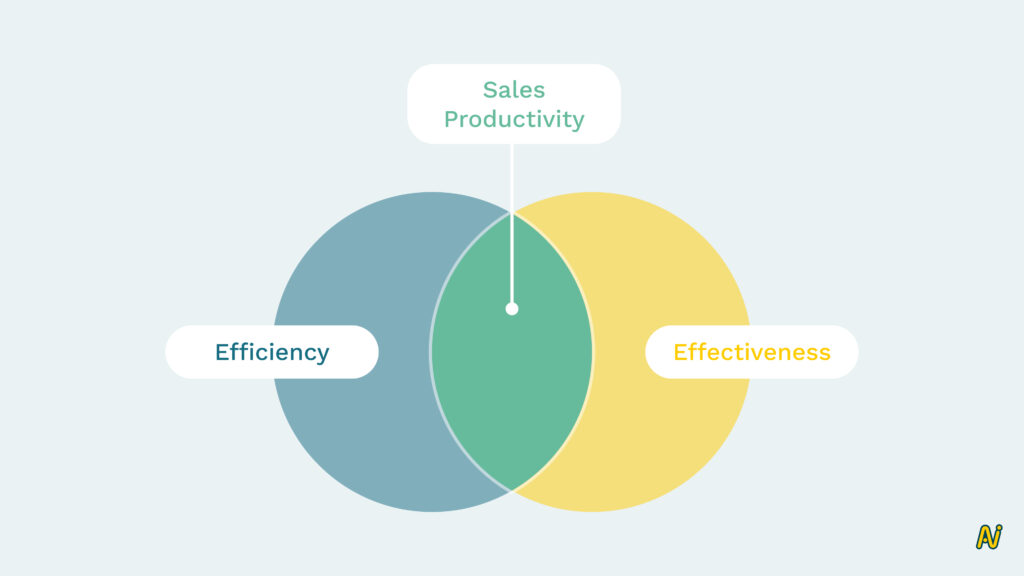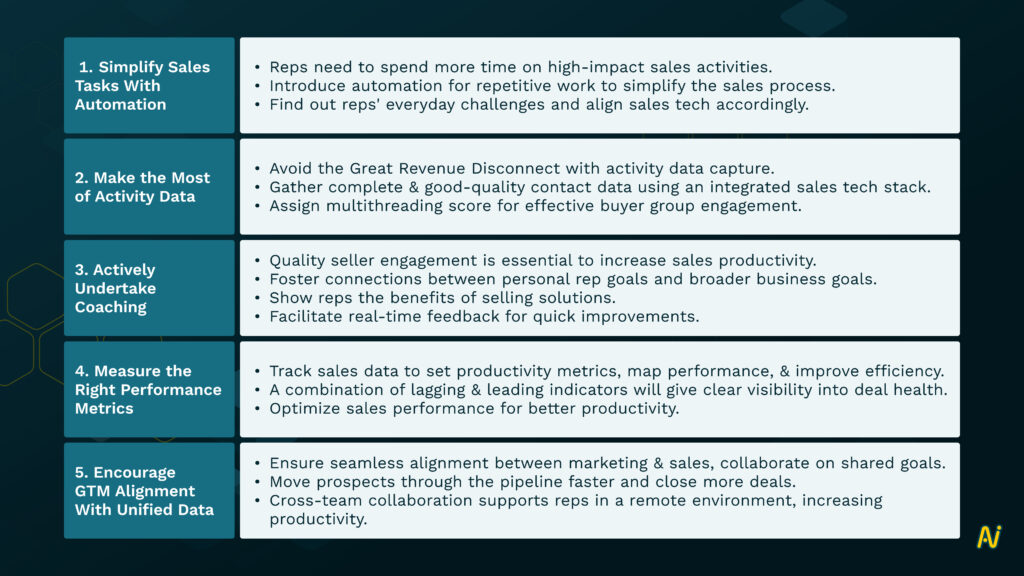Sales productivity is an essential pre-requisite of achieving revenue success, particularly during the current business downturn hitting B2B companies. But it’s easier to aspire for than to make it a reality.
Lack of productivity in sales can lead to shortcomings in processes, pipeline visibility, and sales execution, ultimately causing revenue leakage.
In fact, 81% of reps feel that reducing their time on non-sales activities could be more profitable for their organization. 75% of reps find it challenging to figure out the most valuable opportunities in the pipeline, negatively impacting revenue growth.
Setting up your sales reps for success requires individual and process-driven efforts. Find out how to increase sales productivity in this blog.
Sales Productivity: Sounds Great, But What Does It Really Mean?
Sales teams are productive when they maximize results (output) on critical sales activities while minimizing the resources (input) to achieve goals.
As Sales Hacker rightly sums it up,
Sales Productivity = Efficiency X Effectiveness

- Efficiency refers to the distribution of resources and their usage.
- Effectiveness deals with “how” resources are used to achieve sales goals.
The Reality of Sales Productivity Today
While you may consider your team productive enough, the reality is that 48% of sales professionals don’t feel as productive at work as they used to be before the pandemic hit.
Your bottom line will take a hit if reps don’t feel productive. Let’s first look at the problems plaguing sales teams today to find solutions.
1. Complexity
In the older sales funnel, reps were typically out of the picture once they closed a deal. But the modern sales funnel shows how reps need to be involved even post-purchase by identifying upselling and cross-selling opportunities.
Amidst this, buyers are becoming more digital-savvy and prefer researching independently. This gives reps just 5% of the prospect’s time to gather insights on buyers and influence the purchase decision.
As a result, sellers lack an in-depth understanding of the ideal customer profile (ICP) and key metrics to increase sales productivity.
Then there’s the matter of sales tools. Today’s sales tech stack has an average of 13 tools, and yet, companies have wasted $ 313,000 because reps resist adopting these tools.
Also, they spend more time on administrative activities than prospecting and selling, adding up to one full day of work every week. There are so many complicated activities to finish that 62% of sales reps must put in additional hours after work or on weekends to complete non-selling tasks.
2. Demotivation
If complexity wasn’t enough, reps can’t figure out a more straightforward way to complete their tasks owing to poor training and coaching.
Given the constantly changing business environment, sellers may lose their champion in the buying organization to attrition. Nearly 25% of buyers change their jobs every year.
Lack of visibility into the rest of the buying group doesn’t give reps much confidence in continuing the sale with multiple stakeholders. Instead, they deploy single threading and end up losing deals. 80% of sellers admit that at least one deal was lost or delayed due to a prospect or key stakeholder changing jobs.
It only further demotivates them from improving current selling techniques or adopting new ones.
3. Attrition
Seller attrition is an ongoing challenge, increasing by as much as 39% in 2021. Poor management, onboarding difficulties, low rep engagement, and unfavourable compensation or benefits leave 51% of reps actively looking for new jobs. Instead of “drive,” they feel a heavy “drag” on their productivity.
Add to it the long hours that sales professionals put in. 77% of sellers are working more hours in 2022 compared to two years ago. And 69% are feeling the heat through burnout.
If you thought sales reps were easily replaceable, they’re not. You need to deal with high training and recruiting costs. Reps also establish robust relationships with buyers, which is hard to replicate and replace. If customers feel dissatisfied, they’ll back out, leading to a loss in revenue.
4. Confusion
Misalignment between sales, marketing, and customer success teams leads to chaos and tunnel perspectives. Data silos further create an unclear picture of the lead pipeline, pushing leaders to make poor decisions. 54% of prospecting teams cannot access actionable intelligence in real time.
Without a sales playbook (strategies, processes, and tactics), reps face difficulty planning, scheduling, and prioritizing high-value opportunities.
When managers have delayed insights and ambiguous sales processes to work with, their feedback is unusable and unclear. It restricts 27% of sellers from attaining their quota and putting in the effort to increase sales productivity.
5. Competition
Competition is unavoidable in selling, placing immense pressure on reps to perform well. Sellers are not just constantly looking to achieve targets but also surpass them.
As a result, reps face burnout and slow months, which bring down productivity.
They may feel worse, like they’re stuck in a rut just going through the motions of selling. At least 68% of sellers feel this way, pushing 44% to chase new job opportunities and 34% to miss their sales quota.
Sales Productivity Is Challenging. What Can You Do About It?
Here are 5 proven ways to increase sales productivity.

1. Simplify Sales Tasks With Automation
Reps must prioritize revenue-driving activities but can’t because non-sales activities take up much of their day. 75% of sales reps have new responsibilities at work. And other than selling, they have to complete data entry, quote generation, and documentation, among other administrative tasks.
Another 50% of sellers feel that their processes and workflows are too complicated, resulting in productivity challenges.
For reps to feel genuinely productive, they must spend more time performing critical sales functions. By introducing automation into the sales process for repetitive work, you can simplify the selling process and close deals faster.
For example, sales professionals spend 17% of their time entering data into the CRM. If this process is automated, reps have 17% more time to concentrate on selling and growing the business.
But you need to be careful about not using sales tools just for the sake of it. Before investing in sales tech, find out your reps’ everyday challenges and align their needs with tech accordingly. Integrating your tech stack is also essential, making tools easy to use. When done right, 75% of sales reps find improved ways to increase sales productivity using the integrated organizational tech stack.
2. Make the Most of Activity Data
Revenue leaks, from a lack of visibility into the pipeline, systemic failures, and ineffective sales processes, are significant sources of loss for businesses.
It all starts with not capturing complete data. 79% of opportunity data collected by reps never enters the CRM. Sellers either don’t have enough time to input this data or find the processes and systems too complex to work with.
Even if they manage to capture data adequately, it may be dirty (inaccurate, incomplete, non-compliant, or outdated) owing to manual errors. Dirty data is another revenue offender, causing organizations to lose an average of US$13 million annually.
Other times, the sales tech stack isn’t integrated. So, reps end up using multiple tools for multiple functions. And if the tools are integrated, they don’t provide unified visibility into the sales pipeline and process.
All of the above reasons create The Great Revenue Disconnect and directly impact sales productivity.
Automated activity data capture solutions, like Nektar, let you weave out of these issues, access real-time feedback, and gather intelligence from across the sales tech stack. These insights include:
- Data on where reps spend time and if it’s geared more towards high-impact activities over non-sales tasks.
- Granular information on the selling process, from sales tools to buyer communication channels (including CRM, email, phone, virtual meetings, calendars, Slack, and more).
- Multithreading score and if sellers effectively engage with all stakeholders in each buying group.
Other than insights, activity data capture drives predictable revenue by gathering complete contact data and pipeline opportunities on a unified dashboard and highlighting high-intent deals.
Because all buyer information is in one place, reps can monitor deal progress, understand customer behavior and follow the buyer journey through the sales funnel, from discovery to relationship-building – in real-time.
3. Actively Undertake Coaching
Most companies have a module in place for training new joiners. But what seems to be lacking is continued coaching to improve rep performance regularly. Nearly 38% of sellers find inadequate coaching a barrier to success at work.
Generally, managers train new reps and then have them learn on the job. But trial-and-error isn’t sustainable for letting your reps run the field. Quality seller engagement is the key to increase sales productivity.
Companies where sales managers spend 50% of their time coaching, are 1.4 times more likely to outperform the competition.
- Start with fostering a connection between personal rep goals and broader business goals. Sales reps will feel more encouraged to perform better if they see how much impact on the revenue they create and how it helps you achieve success.
- Buyers look to your sales team for more information about the product. If reps don’t understand what they sell, prospects will walk out the door quicker than they can get new ones onboard. Get reps to see the benefits of selling “solutions” rather than features to counter this problem.
- Facilitate this with real-time feedback and daily performance reports. Look back on your rep’s performance during previous buyer meetings, analyze their call statistics, highlight action points and gauge the overall customer sentiment. You can then provide valuable inputs on converting a cold lead to a winning opportunity.
Consider this. Your rep may spend much time on prospecting and cold outreach, but buyer face time is low. This may indicate that the rep isn’t reaching out to the right ICP. With coaching, you can address the issue quickly and strengthen the sales playbook using actionable insights.
Sellers who receive tailored coaching based on their performance are 1.3 times more likely to do better than the competition.
Coaching has a few more advantages. Reps can’t retain extensive information for long. 87% of sellers forget the information they learn within a month. Moreover, sales processes and tools are constantly evolving. Regular coaching helps keep reps up-to-date with new developments, deploy sales tool use cases in the real world and be confident in their abilities.
4. Measure the Right Performance Metrics
30% of high-performing RevOps organizations struggle to accurately track performance and sales success, much less gain insights from data. The result is – goal setting takes a long time; 23% of sales professionals agree.
Tracking sales data comes with benefits. It lets you set key productivity metrics, map rep performance, and measure them for better efficiency. Most sales organizations rely on lagging indicators to track sales performance. But you’ll do better with a combination of leading and lagging indicators.
Lagging indicators typically include:
- Conversion rate
- Win rate
- Customer lifetime value (LTV)
- Quota attainment
- Pipeline coverage
- Time spent on selling
- Deal size, and more.
As you’ll notice, they paint a picture of your past performance, quantifying your growth so far.
What if there was a way to measure the present, act on insights quickly and set up future predictions? That’s where leading indicators come in. They include:
- Multithreading score
- Deal health score
- Buyer personas
- Value of pipeline opportunities
- Follow ups with warm leads
- Open or response rates
- Buyers’ feedback
Leading indicators give you clear visibility into valuable deals that need additional nurturing and deal health. You can also predict if a rep will successfully sign on a prospect. And if not, guide them in the right direction in real time.
You can accelerate pipeline value using leading indicators by focusing on sales activities that drive better win rates.
But don’t discount lagging indicators entirely. They work together with leading indicators to give you warning signs about low productivity. The more you know, the better you can optimize your sales strategy and processes before your team moves away too much from its goals.
To increase sales productivity, get started with measuring the right performance metrics by:
- Auditing current sales activities
- Determining the impact of these activities, if they are high or low
- Understanding your sales funnel to improve efficiency and effectiveness
- Using leading indicators to guide real-time performance
- Deploying lagging indicators to understand past performance
- Imbibe the overall learnings into the sales playbook through coaching
5. Encourage GTM Alignment With Unified Data
Sales and marketing alignment helps to increase sales productivity to a large extent.
If they don’t work together seamlessly, both teams struggle to create customer value and end up going against each other. Eventually, this is detrimental to the organization’s growth. But sales and marketing isn’t a new concern; it’s a prevailing problem. 9 in 10 sales and marketing professionals agree they are misaligned. And only 38% of businesses have aligned their sales, marketing, and customer success functions.
However, it’s not necessary for marketing and sales to see eye-to-eye on every task. Problems arise when cross-team collaboration doesn’t percolate into their everyday relationship.
Since marketing and sales essentially target the same customer, the handoff from marketing to sales in the funnel must be frictionless and unnoticeable. This, in turn, allows sales reps to spend less time gathering information about the prospect (they already have it, courtesy of marketing) and focus on converting leads to customers instead.
When GTM teams collaborate on shared goals, marketing and sales can move prospects through the pipeline faster, closing more deals. Simultaneously, it’s easier to establish smooth functioning, scheduling, processing, lead qualification, and lead scoring processes.
Cross-team collaboration also supports reps in a remote environment, particularly when hybrid selling is quickly becoming the preferred sales channel. Two-thirds of buyers and sellers prefer remote engagement over in-person meetings.
Additionally, 27% of B2B buyers spend time researching the seller while using up to 10 channels to make a purchase. This gives marketing teams a better chance at nurturing prospects through the sales funnel through various customer touch points.
Nektar’s unified activity dashboard eases sales and marketing alignment by gathering data across the sales and marketing tech stack without rep intervention.
A Single Solution To Increase Sales Productivity
The sales environment today is highly dynamic, with reps busier than ever. Add to that, administrative tasks won’t be going away. But they can be made simpler with technology.
Give your reps the foundation they need with unified activity data capture for cutting down manual efforts, using sales activity data to improve performance, effectively coaching with real-time feedback, and encouraging cross-team collaboration.
Get in touch with our team for an interactive session, and see Nektar’s impact on your sales productivity.








